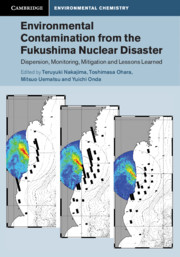 Environmental Contamination from the Fukushima Nuclear Disaster
Environmental Contamination from the Fukushima Nuclear Disaster Book contents
- Environmental Contamination from the Fukushima Nuclear Disaster
- Cambridge Environmental Chemistry Series
- Environmental Contamination from the Fukushima Nuclear Disaster
- Copyright page
- Contents
- Contributors
- Preface
- Acknowledgements
- Part I Transport of Radioactive Materials in the Environment
- Part II Development and Future Issues for the Infrastructure of Disaster Prevention
- Part III Lessons and Future Issues from the Fukushima Accident
- Glossary
- Names of Locations
- Index
- References
Part II - Development and Future Issues for the Infrastructure of Disaster Prevention
Published online by Cambridge University Press: 16 August 2019
- Environmental Contamination from the Fukushima Nuclear Disaster
- Cambridge Environmental Chemistry Series
- Environmental Contamination from the Fukushima Nuclear Disaster
- Copyright page
- Contents
- Contributors
- Preface
- Acknowledgements
- Part I Transport of Radioactive Materials in the Environment
- Part II Development and Future Issues for the Infrastructure of Disaster Prevention
- Part III Lessons and Future Issues from the Fukushima Accident
- Glossary
- Names of Locations
- Index
- References
Summary
The environmental consequences of the atmospheric release of radioactive materials from the accident at the Fukushima Daiichi Nuclear Power Station (FDNPS) were not sufficiently determined in the early stages of the accident, causing serious problems related to off-site countermeasures. One of the key questions faced not only by inhabitants in the affected areas but also by the public, including experts of relevant fields, is whether the confusion and problems in the emergency responses could have been avoided if the spatial extent and temporal evolution of the radioactive plume had been captured by monitoring. In this chapter, we will review the situation of the emergency preparedness related to the monitoring infrastructure at the time of the accident by examining whether the monitoring infrastructure was capable of coping with a large-scale nuclear disaster to determine an appropriate state of preparedness.
- Type
- Chapter
- Information
- Environmental Contamination from the Fukushima Nuclear DisasterDispersion, Monitoring, Mitigation and Lessons Learned, pp. 213 - 256Publisher: Cambridge University PressPrint publication year: 2019


